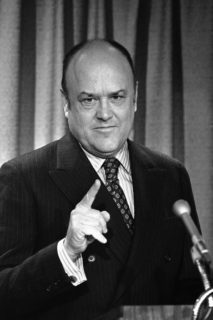
Melvin Laird, the secretary of defense under Richard Nixon, died today. He was 94.
A lot of old-timers probably weren’t even aware the Carleton College alum was still alive, except that his name has come up a few times in the last week as an example of why a president’s cabinet choices are pretty important.
It was Laird, according to Laird himself, who kept Nixon from pushing us to the brink of nuclear war with the Soviets.
CNN, for example, reported this week:
In his authorized biography, former Secretary of Defense Laird tells the chilling story of a late-night call from Nixon in September 1970. The radical Palestinian terrorist group, the Popular Front for the Liberation of Palestine, had just hijacked four planes and flown two of them to an abandoned British airfield in Jordan. The Nixon team debated what to do. Later, in the residence, Nixon apparently lost his patience.
“[B]omb the bastards,” said Nixon, slurring his words, and then ordering the use of jets from the carrier Independence. Laird thought the order nonsensical. The only likely effect would have been to ensure the deaths of the approximately 180 passengers held hostage, when at that point they were not actually in any great danger. But Nixon wanted to send a signal to the Soviets, who sponsored the Popular Front.
Fortunately for the hostages, all of whom eventually made it home alive, and for US Middle East relations, Laird prevaricated. “I told him,” Laird later recalled for his biographer Dale Van Atta, “we would do the best we could. I didn’t have a big argument about it; I just didn’t do it.”
It gets scarier.
In October 1969, Nixon and Henry Kissinger hatched a plan to make the Soviets think the U.S. was willing to launch a nuclear strike against Moscow. To prove it, they launched B-52s with nukes and sent them to the boundaries of the Soviet Union. It’s known now as the “madman theory,” an attempt to convince Moscow that Nixon was just crazy enough to do it.
Here’s Wired’s account of the secret global nuclear alert:
The aircraft were pointed toward Moscow, but the real goal was to change the war in Vietnam. During his campaign for the presidency the year before, Richard Nixon had vowed to end that conflict. But more than 4,500 Americans had died there in the first six months of 1969, including 84 soldiers at the debacle of Hamburger Hill. Meanwhile, the peace negotiations in Paris, which many people hoped would end the conflict, had broken down. The Vietnamese had declared that they would just sit there, conceding nothing, “until the chairs rot.” Frustrated, Nixon decided to try something new: threaten the Soviet Union with a massive nuclear strike and make its leaders think he was crazy enough to go through with it. His hope was that the Soviets would be so frightened of events spinning out of control that they would strong-arm Hanoi, telling the North Vietnamese to start making concessions at the negotiating table or risk losing Soviet military support.
Secretary Laird opposed the operation, and had earlier resisted a Nixon order to prepare it. He was worried that the Soviets would either interpret the alert as an attack or — perhaps worse — a bluff.
Laird, who represented the Stevens Point area of Wisconsin in Congress before joining Nixon’s cabinet, is also the man who ended the military draft.
